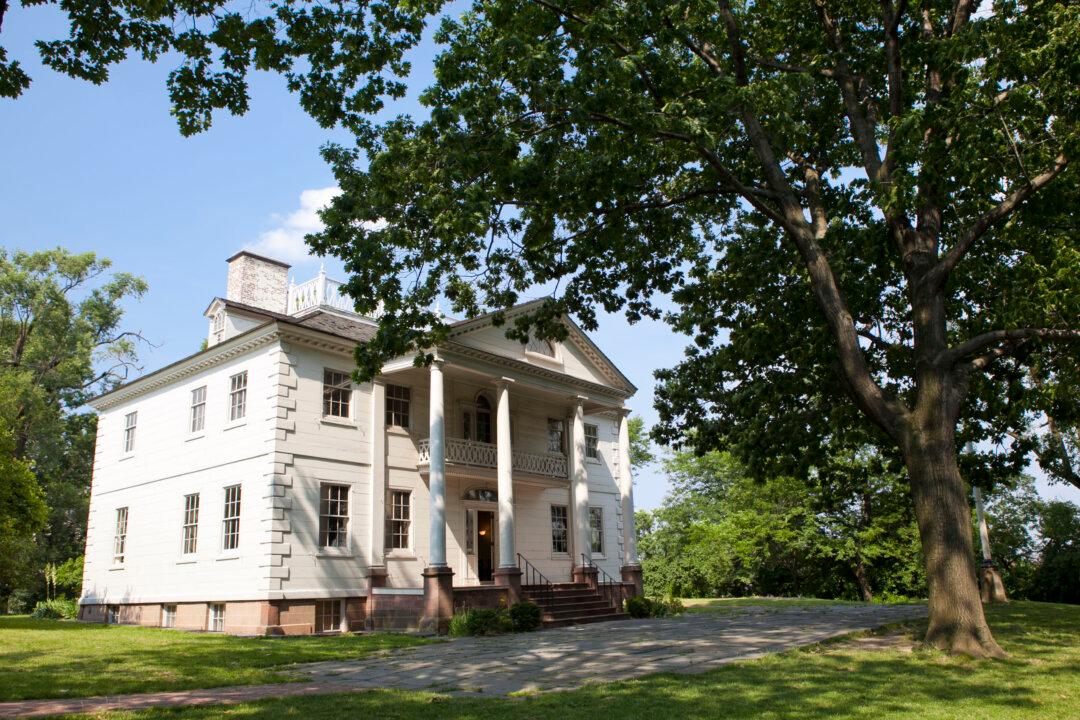NEW YORK—The weather was 90 degrees, sticky, and the air stood still. But 40 people, both young and old, volunteered to spend an entire day in a creaky house without air conditioning, learning the proper way to hold teapots and place hats in boxes.
They’re not crazy. They’re the Roof Raisers Curatorial Brigade. And after certification, they will become integral to the survival of New York’s historical houses as cultural institutions.
The trainees, some of whom are former museum professionals or museum studies students, gathered at the Morris-Jumel Mansion in Washington Heights on June 25.
“Our goal is to develop a pool of trained volunteers who can help out at any of our 23 houses, many of which do not have curators,” said Caroline Drabik, curator at Historic House Trust. Drabik spent the day teaching alongside partners from Greater Hudson Heritage Network (GHHN).
Her organization, Historic House Trust, works as liaison between the Parks department and the boards of each historic house to make sure these historical sites are kept up and able to serve the community fully.
The Morris-Jumel Mansion, built in 1765, is the oldest house in Manhattan. Built in the Palladian style at the top of an idyllic hill, the house belonged to a British colonel before he and his family were driven back to Britain.
George Washington took it as his headquarters briefly in 1776 before French wine merchant Stephen Jumel purchased it in 1810. After her husband’s death Madame Jumel (a controversial figure in her own right), married the famed Aaron Burr. All these characters’ lives were tied at one point or another to this one house, which operates today as a museum.
Dedicated Volunteers
Under the tutelage of curatorial volunteers, the trainees used the objects in the mansion’s collection as learning tools. They rotated among four stations to practice how to properly handle, clean, pack, and catalog museum objects.
This was the fourth of five such training sessions held in June—one in each borough. In the fall, they will be deployed based on their personal availability to help with basic curatorial work.
The Roof Raisers program is in its first year. Drabnik estimates that in this first year it will have trained 200 volunteers.
The day began with the group seated in folding chairs watching educational videos. Then, after a brief lunch, they got hands-on.
Britney Schline, an intern with the Historic House Trust, was stationed at Table 1. She taught how to carry various objects—ceramics, paintings, wood, furniture, paper, and textiles.
“Remember, base and body,” she said, lifting an ornate decanter. “Hold it by the base and support the body. If you do break an object while you’re handling it, just tell the curator. We’ve all done it.”
The trainees listened attentively, almost entranced by the demonstrations.
At Table 2, Drabik introduces trainees to simple tools with which they can clean furniture and delicate textiles. She hands each person a Japanese watercolor brush and coaches the right amount of flick in the wrist. They huddle around an antique wicker chair to try their technique and quickly graduate to using the brush in conjunction with a vacuum cleaner.
Mandy MacKenzie, speaking with an animated Scotland accent, teaches packing at Table 3. More seasoned trainees volunteer their own advice on which archival materials are best for which types of documents.
“You could take an entire class just on this,” one of them said.
At Table 4, trainees test their art history knowledge in a session on cataloging collections. Priscilla Brendler, executive director at the Greater Hudson Historical Network, discusses the nitty-gritty of noting the history, condition, and physical description of various objects.
The group nods in appreciation when Kerry Sclafani, GHHN program coordinator, shares tips on dating photographs.
Pulling Together
As cultural institutions suffer from public funds drying up and the reduced ability of private individuals to contribute, houses like Morris-Jumel continue to rely on the man-hours of volunteers.
Carol Ward, director at Morris-Jumel Mansion, spends each day on her bright blue walkie-talkie making sure that the house operates properly for its 16,000 annual visitors, 7,000 of whom are second- and fourth-graders.
“Everyone is so surprised that it’s survived for this long,” Ward said of the 237-year-old house. “Especially for students, they are amazed that it’s right in their backyard. They’re walking around the house and standing in the same spot that George Washington stood on. When I have a fourth grade boy say that’s the coolest moment of the school year, I’ve done my job.”
Ward is the only full time staff at Morris-Jumel. She relies on a handful of young part-timers to lead tours and work on exhibits while she busies herself with marketing, finances, and grant writing—the mansion’s main source of funding.
“The two main challenges you would hear from most directors is budget and staffing,” Ward said. “If we had an unlimited budget we could do bigger exhibitions, have more staff, and get more curatorial supplies. Then, you have to make sure you have enough staff and trained staff, and that’s where this program is really going to help out.”
Through community outreach programs like Roof Raisers, which was made possible by the Rockefeller Brothers Fund, New York’s historic houses are turning a challenge into an opportunity.
“The beauty of the RRCB is that it turns this need into an opportunity for community engagement—something all museums currently seek,” said Drabik.
Drabik’s been teaching and supervising trained historic house museum volunteers for about eight years.
“By nature, volunteers have big hearts and care deeply about the cause they support, so for me, it is enjoyable and rewarding to engage this special energy,” Drabik said.






